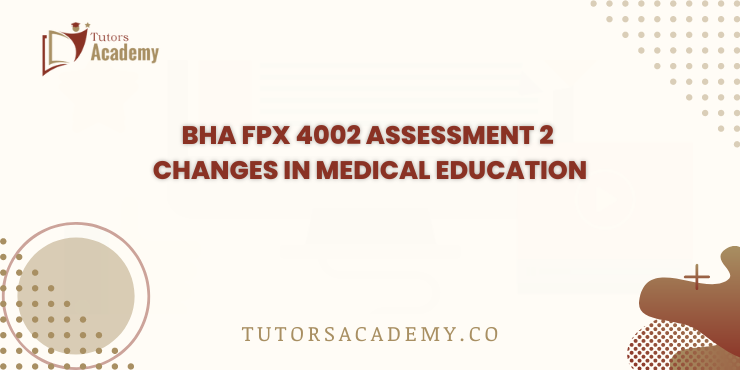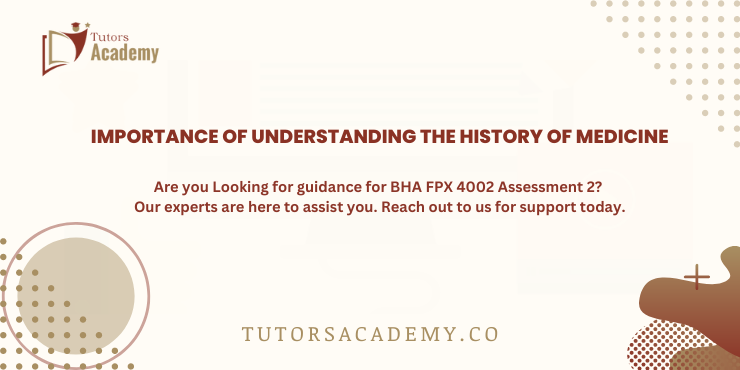
- BHA FPX 4002 Assessment 2 Changes in Medical Education
Changes in Medical Education
This paper aims to explore and document the advancements in medical education from the 1800s to the current times and how it has evolved to cater to the current society’s needs and expectations, the technological changes, and general growth in the knowledge of curing diseases.
The research paper under discussion is devoted to the changes in medical education with a special reference to the shift from apprenticeship to the academic approach and its qualitative impact on the medical training process. This examination aims to review how previous practices have influenced the present educational paradigms and recognize how historical knowledge may be applied to the enhancement of medical practice in the future.
In the 19th century, medical education and medical training were mainly by clinical clerkship or by following the path of apprenticeship by having the required experience with the medical practitioners. This model included active practice but had no regularity and rigidity of the lessons.
The relatively recent change can be seen with the arrival of the Flexner report, which called for radical changes in medical education by proposing a more formal and rigorous academic approach (Young & Kroth, 2019). This change started a standardization of curriculum and assessment, the steps towards modern medical education.
The Changing Scope of Medical Education
It was in the course of the early part of the 20th century that a revolution was wrought by the Flexner Report of 1910. This influential document called for a strict syllabus and established the structure of medical training.
The standards highlighted the importance of a scientific approach in medical education and proclaimed the general requirements for the length and organization of the medical courses (Young & Kroth, 2018). This reform paved the way for the creation of the academic medical institution and the structured method of producing physicians in the country.
Technological Advancements
The second half of the twentieth century and the twenty-first century can be characterized as rather progressive in terms of medical education advancements due to the technological impact.
Simulation labs and the use of augmented reality and virtual reality have brought about a dramatic change in the training of doctors as they enable learners to practice on real patients with the utilization of high technology practices without compromising on the patients’ lives (Harden & Laidlaw, 2019).
These technologies make it possible for students to rehearse and excel, especially in critical incidents, improving their actual life experiences based on medical situations.
Other technological developments, such as robotic-assisted surgery and minimally invasive procedures, also affect medical education. Kisi 2 These technologies call for methods and skills which must be incorporated into training and course development to guarantee that physicians are well-equipped and fully capable of using the new technologies (Gordon et al., 2021).
RPM and telemedicine have also emerged as significant components of today’s medical education, which has become more patient-oriented and interconnected in recent years (Gordon et al., 2021).
Mandated and Cultural Changes
It is noteworthy that the changes in the medical education occurred not only due to the external requirements, but also due to the cultural processes. Essential changes, like those prescribed by the Flexner Report, have delineated the school and professional prerequisites for medical education and practice, providing benchmarks that define curriculum standards and coherence (Young & Kroth, 2018).
They help ensure that the practitioners delivering health care services meet the required standard of competency and professionalism.
Impact of New Technologies
In this paper, one can observe how the introduction of newer technologies significantly and extensively affects medical training. New approaches to learning, using augmented and virtual reality, have improved learning outcomes by providing real-life cases for practice, enabling solutions of common clinical problems in a controlled area (Harden & Laidlaw, 2019).
With the help of robotic systems incorporated into surgical practice, the levels of accuracy and maneuverability have risen to the challenge. Thus, further education becomes a must for future surgeons.
Apprenticeship Model vs. Academic Model
During the 1800s, apprenticeship was the most common model of education in medical training. In this system, one had to train to become a physician by following the examples of already set physicians. This was a fairly loose approach aimed at watching other experienced doctors at work, with an especially important focus on the practice that entailed the acquisition of various proficiencies resulting from hands-on training (Young & Kroth, 2019).
However, this model had many problems. The most significant was the absence of a standard curriculum, which led to sharp differences in the extent of the training provided to professionals at the time of their employment. The level of theoretical knowledge was generally low; little time was spent on lectures, and frequently, only the immediate use of the animals as learning objects was planned.
The process of evolution in medical education in the nineteenth and early twentieth centuries in the United States had been marked by major changes by the 1960s, following the recommendations made in the Flexner Report in 1910. This report was for adopting an official academic format that entailed the incorporation of sane structured curricula and accredited training programs in medical schools (Young & Kroth, 2018).
BHA FPX 4002 Assessment 2 Changes in Medical Education
The academic model focused on both theory and practice and included lectures combined with clinical practice. It brought out theoretical training that goes hand in hand with practical experience and developed professional courses and license exports. This shift was intended to raise the medical training processes’ overall coherence and scientific validity.
Medical education progress also continued in the early 2000s with the incorporation of new technologies. The curriculum gathered more simulation labs that enabled the practice of clinical skills in a controlled system devoid of patients (Harden & Laidlow, 2019). This period included multimedia integration in learning and the initial application of augmented reality (AR) and virtual reality (VR) for learning. It also resulted in a greater interest in the concepts of evidence-based medicine and patient safety, as well as the elevation of the role of teamwork and communication.

Importance of Understanding the History of Medicine
Medical education history is important in enhancing the future practices because it allows comprehension of the training trends, identification of past accomplishments and failures, and formation of the direction for the continual enhancement. Moreover, by understanding the history, the educators and policymakers will be in a better position to understand the basis on which the current systems have been developed and establish where the improvements can still be made.
Historical insights can support both findings and practices of current, modern educational practices. Presumably, when people want to know the history of a certain field, they can influence the present state of this field. Still, these reviews can inspire the implementation of reforms or the desire to bring certain changes in their field.
For instance, the Flexner report was published in 1910, which brought drastic changes to the medical curriculum by setting out the structure and emphasizing the scientific approach to learning. With this historical understanding, it is possible to appreciate why medical schools today have structures and course curriculum that are proven to work. It emphasizes such values as high standards of education and the ability to update the knowledge according to the existing scientific achievements.
Learning from Past Reforms
Historical analysis is important in social sciences as it identifies lessons that can be learned from experiences with past reforms and their outcomes. The replacement of apprenticeship tradition with academic one at the beginning of the twentieth century signified a progress in stability and quality of the medical education.
The common apprenticeship model from the 1800s to date always exhibited an inconsistent degree of training since it was not structured. Learning about some of these changes can help modern educators understand that following changes can be useful and apply some of them to solve modern problems in medical education, for example, adapting new technologies into the curriculum or identifying weaknesses in the training process.
Guiding Future Innovations
History also determines when to introduce new systems and technologies for improvement. For instance, the introduction of simulation labs, used in the early 2000s that included AR and VR as formidable technologies for training, was catalyzed by the necessity for better training methods.
These innovations are based on the analysis of previous educational paradigms, showing constant improvement and change. The knowledge of the past developments of such advancements enables the upcoming educators to predict future needs and develop teaching methods sensitive to the changing nature of the healthcare sector.
Conclusion
In conclusion, although medical education began in the 1800s, there has been a transformation in the structure of the programs and the technology used from then up to the present. The training developments started from the informal apprenticeship model of the 19th century to the stringently academic programs of the 20th century, and then to the technologically sophisticated model that is in practice in the present century; this shows a process of evolving to achieve better quality and effective models in producing practitioners in the medical field.
The shift from apprenticeship to academic models increased the quality of education as there was more standardization and formality in medical education. The change induced by the Flexner Report and the following transformations established the base model for contemporary curricula in Medical Colleges where the theoretical and practical elements are intertwined.
Several degrees of the training process evolution contributed to enhancing training in skills development, such as the incorporation of simulation labs, augmented reality (AR), and virtual reality (VR) Width of degree. The medical education programs of the present era reap the advantages of advancements like robotic surgery, telemedicine, and personalized medicine.
These trends are recalculating the focus on technological preparedness and the patient requirements of the healthcare sector. Incorporating these technologies in a training program is important because Medical education equips future professionals to work in today’s diverse and ever-evolving healthcare systems and environments, thus ensuring quality patient outcomes.
If you need complete information about class 4002, click below to view a related sample:
BHA FPX 4002 Assessment 1 Evolution of the Hospital Industry
References
Buja, L. M. (2019). Medical education today: All that glitters is not gold. BMC Medical Education, 19(1).
https://doi.org/10.1186/s12909-019-1535-9
Emanuel, E. J. (2020). The inevitable reimagining of medical education. JAMA, 323(12), 1127.
https://doi.org/10.1001/jama.2020.1227
Gordon, M., Patricio, M., Horne, L., Muston, A., Alston, S. R., Pammi, M., Thammasitboon, S., Park, S., Pawlikowska, T., Rees, E. L., Doyle, A. J., & Daniel, M. (2020). Developments in medical education in response to the COVID-19 pandemic: A rapid BEME systematic review: BEME guide no. 63. Medical Teacher, 42(11), 1–14.
https://doi.org/10.1080/0142159x.2020.1807484
Han, E.-R., Yeo, S., Kim, M.-J., Lee, Y.-H., Park, K.-H., & Roh, H. (2019). Medical education trends for future physicians in the era of advanced technology and artificial intelligence: An integrative review. BMC Medical Education, 19(1).
https://doi.org/10.1186/s12909-019-1891-5
Lucey, C. R., & Johnston, S. C. (2020). The transformational effects of COVID-19 on medical education. JAMA, 324(11).
https://doi.org/10.1001/jama.2020.14136
Papapanou, M., Routsi, E., Tsamakis, K., Fotis, L., Marinos, G., Lidoriki, I., Karamanou, M., Papaioannou, T. G., Tsiptsios, D., Smyrnis, N., Rizos, E., & Schizas, D. (2021). Medical education challenges and innovations during COVID-19 pandemic. Postgraduate Medical Journal, 98(1159), postgradmedj-2021-140032.
https://doi.org/10.1136/postgradmedj-2021-140032
Pottle, J. (2019). Virtual reality and the transformation of medical education. Future Healthcare Journal, 6(3), 181–185.
https://doi.org/10.7861/fhj.2019-0036
So, H. Y., Chen, P. P., Wong, G. K. C., & Chan, T. T. N. (2019). Simulation in medical education. Journal of the Royal College of Physicians of Edinburgh, 49(1), 52–57.
